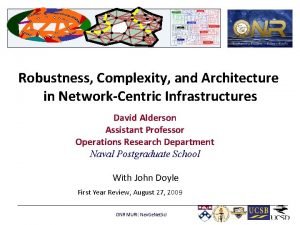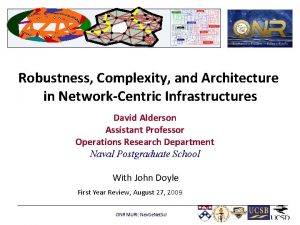NetworkCentric Analysis and Representation Requirements for Successful Effects












- Slides: 12

Network-Centric Analysis and Representation Requirements for Successful Effects Based Operations Resilient Cognitive Solutions James Gualtieri, William Elm, & Jay Peffer

Hurdle to Success • Functional Relationships in adversary systems are at the heart of Effects Based Operations (EBO) – This abstract functional thinking is difficult – Military planning community struggles to do it • Applied Cognitive Systems Engineering (ACSE) seeks to understand these same Functional Relationships for systems design – Developers tend to drift to focusing on the Physical rather than the Functional – Concrete Physical thinking is easier 1 EBO and ACSE are the both natural extensions of the same science

Effects-Based Operations Effects Based Operations “is a methodology for planning, executing and assessing operations to attain the effects required to achieve desired national security objectives. “ AFDD 1 The focus tends to be on assessing what physical actions produce the desired behavioral effects 2 Objective Effect MOEs Action The Real Challenge is identifying Effects and their relationship to Objectives

Mapping Physical to Functional • Function is a property of a physical object – its goal or purpose • Identifying the relationship between the physical and functional world is critical for EBO • The same Function can often be accomplished by different Physical objects 3 Functional substitutes impact the effectiveness of combat actions

Focus on the Physical Alone Insufficient Strategy Development Tool Effects-Based Plan Representation Objective Effect Desired • direct effect • indirect effect • complex effect • cumulative effect (Isolate the Battlefield) Indicator Task/Activity (Deny Access) (Name) Mechanism Traditional EBO Representations Do Not Accurately Portray the Relationship Between Physical Components and Functional Effects 4 Tools must reflect true complexity of domain not just surface features

How does Missing Information Impact Decision Making? • Representation impacts thinking – User likely to become target fixated – Functional concepts, like transportation, missing – What other Functions are “riding” on Bridge 1? – Side effects invisible – user can’t remember all functions – Trade-offs not obvious 5 Complexity of cognitive work not reflected in tool

Many-to-Many • Complex relationships exist between Physical entities and Functional properties – Relationships look simple from the perspective of any one physical entity – Impact of a single event can have a multitude of effects • From a physical perspective, EBO decision-makers are unable to see and understand these cascading effects 6 Many-to-Many relationships are a property of all complex systems

Support Tools Critical for EBO • Managing physical to functional mappings and many-tomany relationships is very difficult • To be effective, EBO decision makers need tools that promote abstract thinking – Make functions and relationships explicit – Support runtime execution not just planning 7 Functional model of domain must be integrated into support environment

A New Approach to Tool Development • Applied Cognitive Systems Engineering (ACSE) is based on understanding functional concepts within a domain 8 Capturing abstract functional concepts improves support tool development

Visualization Requirements • Build Correspondence Between the Domain and Representation – Provide frames of reference that capture meaningful relationships in domain – Put information into context – Highlight changes and events – Highlight departures from a referent 9 Systems must respect how humans think and domain constraints

ACSE Based Visualizations • Visualizations of functional abstractions dramatically improves decision-making under stress • Representing effects as a functional abstraction network improves effectiveness 10 ACSE-based tools enable warfighters to rapidly assess information

Conclusion • Functional relationships must be considered for EBO to be effective – It requires more than just an inventory of physical components • Functional concepts and relationships are at the heart of ACSE – It provides a framework for developing tools to support effective EBO • Decision-makers must succeed at thinking functionally – There is a tactical advantage – Provide ability to invent new tools
 Formuö
Formuö Typiska novell drag
Typiska novell drag Nationell inriktning för artificiell intelligens
Nationell inriktning för artificiell intelligens Vad står k.r.å.k.a.n för
Vad står k.r.å.k.a.n för Varför kallas perioden 1918-1939 för mellankrigstiden
Varför kallas perioden 1918-1939 för mellankrigstiden En lathund för arbete med kontinuitetshantering
En lathund för arbete med kontinuitetshantering Särskild löneskatt för pensionskostnader
Särskild löneskatt för pensionskostnader Personlig tidbok
Personlig tidbok Sura för anatom
Sura för anatom Förklara densitet för barn
Förklara densitet för barn Datorkunskap för nybörjare
Datorkunskap för nybörjare Stig kerman
Stig kerman Att skriva en debattartikel
Att skriva en debattartikel























